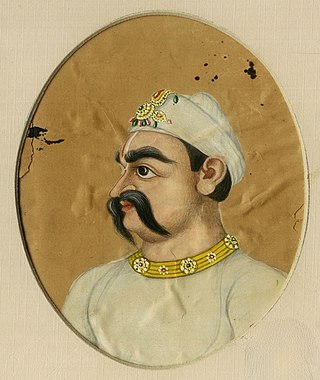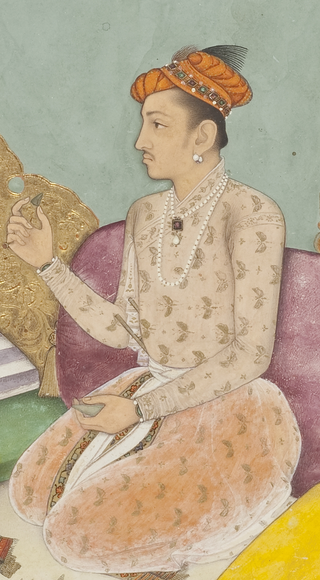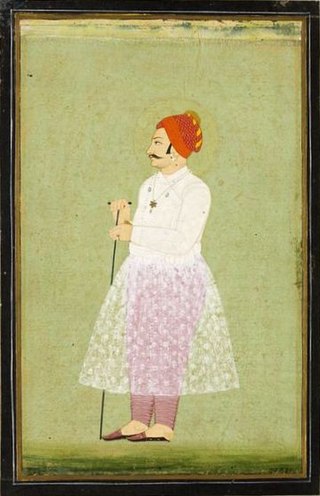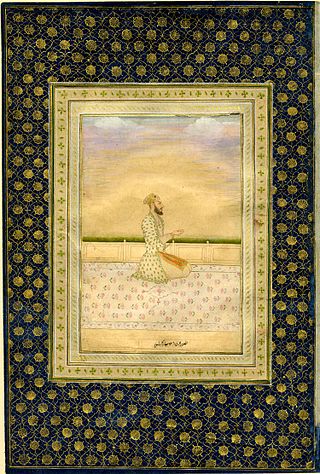Related Research Articles

Farrukhsiyar, also spelled as Farrukh Siyar, was the tenth Mughal Emperor from 1713 to 1719. He rose to the throne after deposing his uncle Jahandar Shah. He was an emperor only in name, with all effective power in the hands of the courtier Sayyid brothers.

Suraj Mal was a Jat ruler of Bharatpur in present-day state of Rajasthan. Under him, the Jat rule covered the present-day districts of Agra, Aligarh, Bharatpur, Dholpur, Etawa, Hathras, Mainpuri, Meerut, Ghaziabad, Mathura, and Rohtak, Sonipat, Jhajjar, Nuh, Palwal, Faridabad, Kasganj, Mainpuri, Firozabad, Bulandshahr.

Ajit Singh Rathore was the ruler of Marwar region in the present-day Rajasthan and the son of Jaswant Singh Rathore.

Churaman was a Jat chieftain of Sinsini, Rajasthan. He became leader of the Jats after Rajaram's death. Bahadur Shah I made him a mansabdar after he supported him against Muhammad Azam Shah in becoming the emperor. He was also made the faujdar of Mathura, and the imperial highway from Delhi to Agra was placed under his protection by the Mughal Emperor.

Badan Singh was the formal founder of the princely state of Bharatpur. He was the nephew of Rao Churaman Singh. After Churaman's death on 22 September 1721 there were family disputes between Badan Singh and Muhkam, son of Churaman. Badan Singh aligned with Jai Singh II of Jaipur to avoid the anger of Muhkam Singh. In this family feud, Jai Singh supported Badan Singh.

Ballabgarh, officially Balramgarh, is a large town, nearby Faridabad city and a tehsil (subdistrict) in Faridabad district of Haryana, India, and is part of the National Capital Region. The town was founded by Raja Balram Singh, in 1739, who also built the Nahar Singh Mahal palace in the same year. Raja Nahar Singh (1823–1858) was the last king of the princely state. He was executed for taking part in the 1857 war of independence in 1858. The town of Ballabhgarh is only 17 miles (27 km) from Delhi, and today lies on the National Highway 19, a major portion of historical Grand Trunk Road. It is connected to Faridabad and south-east Delhi by the Delhi Metro. Ballabhgarh is the fourth city in Haryana to get metro connectivity after Gurgaon, Faridabad and Bahadurgarh.

Jawahar Singh was a Jat ruler of the Bharatpur State. He succeeded to the throne when his father Suraj Mal died in 1763.

The Kingdom of Amber, also known as Kingdom of Dhundhar and Jaipur State, was located in the north-eastern historic Dhundhar region of Rajputana and was ruled by the Kachwaha Rajput clan. It was established by Dulha Rai, possibly the last ruler of the Kachchhapaghata dynasty of Gwalior who migrated to Dausa and started his kingdom there with the support of Chahamanas of Shakambhari in the 12th century. Mostly through 12th to 15th century, the kingdom faced stagnation, sources were scarce. Under its ruler, Raja Chandrasen Amer became a Sisodia vassal and fought in the Battle of Khanwa under Raja Prithviraj Kachhwaha.

Mirza Raja Jai Singh I was the senior most general and a high ranking mansabdar at the imperial court of Mughal Empire as well as the Kachwaha ruler of the Kingdom of Amber. His predecessor was his grand uncle, Mirza Raja Bhau Singh,the younger son of Mirza Raja Man Singh I

Mirza Raja Bishan Singh was the Kachwaha Rajput ruler of the Kingdom of Amer .He succeeded his grandfather Mirza Raja Ram Singh I since his father Kishan Singh died in the lifetime of his grandfather.He was also the subahdar of the province of Assam from the year 1687 to 1695 in the reigning times of Mughal Emperor Aurangzeb.He is known to have fathered one of the most eminent political icons of 18th century India i.e Sawai Jai Singh II.

Kingdom of Marwar, also known as the Jodhpur State under the British, was a kingdom in the Marwar region from 1243 to 1818 and a princely state under British rule from 1818 to 1947. It was established in Pali by Rao Siha, possibly a migrant Gahadavala noble, in 1243. His successors continued to struggle against regional powers for domination and 9 out of 15 rulers till 1438 died in combat. In 1395, its capital was changed to Mandore by Rao Chunda of Mandore and to Jodhpur in 1459 by Rao Jodha.
The Battle of Maonda and Mandholi was fought between the Rajput rulers of Jaipur and the Jat rulers of Bharatpur in 1767 in Rajasthan. Jawahar Singh of Bharatpur was leading an army back from Pushkar when the forces of Madho Singh of Jaipur met them by Maonda and Mandholi villages, near present-day Neem ka Thana. The battle resulted in the rout of the Bharatpur army by the Jaipur forces.

Bharatpur State, which is also known as the Jat State of Bharatpur historically known as the Kingdom of Bharatpur, was a Hindu Kingdom in the northern part of the Indian subcontinent. It was ruled by the Sinsinwar clan of the Hindu Jats. At the time of reign of king Suraj Mal (1755–1763) revenue of the state was 17,500,000 rupees per annual.

Muhammad Bidar Bakht was a Mughal prince. His father, Muhammad Azam Shah, briefly reigned as Mughal emperor in 1707. Bidar was noted for being a gallant, skilful and successful general and was regarded as the most able Mughal prince of his time. He was the favourite grandson of Emperor Aurangzeb.

Abhai Singh Rathore was an 18th-century Indian Raja of the Kingdom of Marwar (Jodhpur).

Bakht Singh or Bakhat Singh was an 18th-century Indian Raja of the Rathore Clan. Born in 1706, he ruled over various domains in the Jodhpur and Marwar states and was a major political force during his life.
The Battle of Delhi (1764) was fought between the Jat ruler of Bharatpur and the Mughal rulers of Mughal Empire. Maharaja Jawahar Singh of Bharatpur invaded Delhi and laid siege to stronghold of Red Fort.

The Rajput rebellion began in 1708, due to the harsh treatment of the Rajput Rajas by the Mughal emperor. It erupted into a two-year rebellion that forced the Mughal emperor to sue for peace, give them gifts, and restore the Rajput holdings which had been annexed by the previous Mughal emperor Aurangzeb.

Ballabhgarh estate, historically known as Ballabgarh estate was a jagir or estate in Haryana, India, ruled by Jats of Tewatia clan. It was founded by Jat king Raja Gopal Tewatia on 1705.
References
- ↑ Dow, Hindustan, II, 352
- ↑ Dwivedi, Girish Chandra (2003). The Jat : their role in the Mughal Empire. Vir Singh. Delhi: Originals. p. 88. ISBN 81-88629-08-1. OCLC 57436527.
- ↑ Jadunath Sarkar, History of Jaipur: C. 1503-1938, pg171